Return to the Last Frontier
It had been five years since my brother and I had hunted Alaska. In the meanwhile we had been to Namibia and Newfoundland together and to Colorado on separate (and unsuccessful) hunts. We both had a yearning for that vast emptiness of the north. For me particularly, it was a yearning not only for the untrammeled character of the last frontier, but for the purity of the hunt itself. Our experience in Newfoundland left a noxious taint that lingered still, faint but persistent, and my frustrating hunt in November 2002 in Colorado, in which I came achingly close to success had been spoiled by, not the failure, but the exploitation of an unscrupulous outfitter who overbooked the camp in the last week of the season (we had seventeen hunters instead of the advertised six). Both of these outfitters asked a lot of money for almost nothing in return and the surprisingly unpleasant personality of each proved the most unwelcome of camp mates on those hunts. I worked very hard on both hunts, hopelessly in Newfoundland and with slim, but real hope in Colorado and of this I have no regrets. But the hunt experiences had been spoiled by lousy outfitting and worse company. My brother and I were ready to restore purity to the experience; hunting in unquestioned fair chase, with deep respect for the game and love of the chase, in conditions that might be primitive, but were well provided, and where we knew beyond any doubt that there would be game.
We made arrangements with Mark Lang of Lake Clark Air, the same outfit that we hunted with in October of 1999. Once again we would be hunting the Mulchatna herd in the Alaskan peninsula, but this time in an alpine setting and a month earlier in the season. We didn't know exactly what these differences would imply, but we wanted to try a change of environment for the sake of variety. Finally, my brother announced that he intended to hunt in as traditional a manner as practicable (and sound - after all, we would be utterly isolated for several days).
A Traditional Rifle
A traditional hunt suited me well. Modern hunting exploits generally leave me cold and while I appreciate the advance of technology, it lacks the allure of old fashioned blue steel and walnut wood. The same can be said for the current crop of ultra magnums. I find nothing in any of the overbore monstrosities worth acquiring. The magnums of forty and fifty years ago are all that anyone ever need ask for, unless they are asking for less (yes, I do like the short action magnums and if I ever replace my beloved .340 Weatherby it will likely be with a .338 WSM, when it finally emerges from the USRAC-Winchester shop).
So, what rifle for this hunt? At first I settled on a very Selous influenced choice: a Ruger No. 1 Medium Sporter with an elegant 26-inch barrel and chambered for the 7 mm Remington Magnum. Not too traditional you say? Well, if loaded like a .275 Holland and Holland or .280 Jeffery circa 1911, using a 160 grain bullet at 2700 fps, it is quite traditional, if a bit newfangled. I bought a New England Custom Guns aperture rear sight that fitted to the Ruger dovetail mount and I also had a Leupold Vari-X III scope in 1.5-5X that would be appropriate if kept on a suitably low power setting. [This was the rifle that I later used on a mule deer hunt in Nebraska in 2005.]
I had resolved my choice of rifle when I was bitten by the Mannlicher-Schoenauer bug. This is a rifle of which I had read much over the years, but I don't think I had ever actually handled one. When I finally began to investigate the weapon I was obsessed with owning one. Contrary to popular thought, the term Mannlicher does not refer to a full length stock, a feature found on some carbines produced by the Austrian gun making firm of Steyr-Diamler-Puch AG (only some of the carbines had that full length stock and I far prefer the rifles); rather, it is the name of the Austrian answer to Peter Paul Mauser and John Browning, one Ritter Ferdinand Mannlicher. There are several Mannlicher rifles dating from the late 1880s, and all Steyr brand hunting rifles to this day carry the name Mannlicher even though there is no remnant of the old boy's touch left in them. Mannlicher was a genius, who took the best atttributes of the Mauser-derived 1888 Commission Rifle and other designs to create what is arguably the most elegant and sophisticated bolt action rifle design ever produced, beginning in 1900. The name Schoenauer is that of the man who designed its unique and amazingly compact rotary spool magazine. Mannlicher-Schoenauer rifles were originally produced in 6.5 x 54 mm (1900 & 1903 Models), 9 x 56 mm calibers (1905 Model), 8 x 56 mm (1908 Model) and 9.5 x 56 mm (1910 Model), but in 1924 there was a High Velocity Rifle (aka Sequoia) produced in .30`06 Springfield. Post-World War I arms limitations put a real crimp on rifle production, even for sporting use, else this rifle would doubtless have been even more famous. Numerous notable hunters used the Mannlicher-Schoenauer with great success, typically in 6.5 x 54 mm caliber, although the 9.5 x 56 mm was quite popular with the British, who called it the .375 Rimless Nitro Express. Production of the 1903 action resumed in 1950 and it was imported into this country in American chamberings in the 1950s and 1960s, with several slight design changes over the years.
I managed to get a pretty decent 1950 Model rifle in .30`06 Springfield caliber (since restocked by my brother in a very nice piece of Bastogne walnut). The vintage Leupold 3-9X scope that came with it ruined the lines and the traditional sensibilities, but I replaced that with a Leupold VX-II 1-4X. I had a great load for 200 grain North Fork bullets at 2550 fps. Once again, I thought my choice was made.
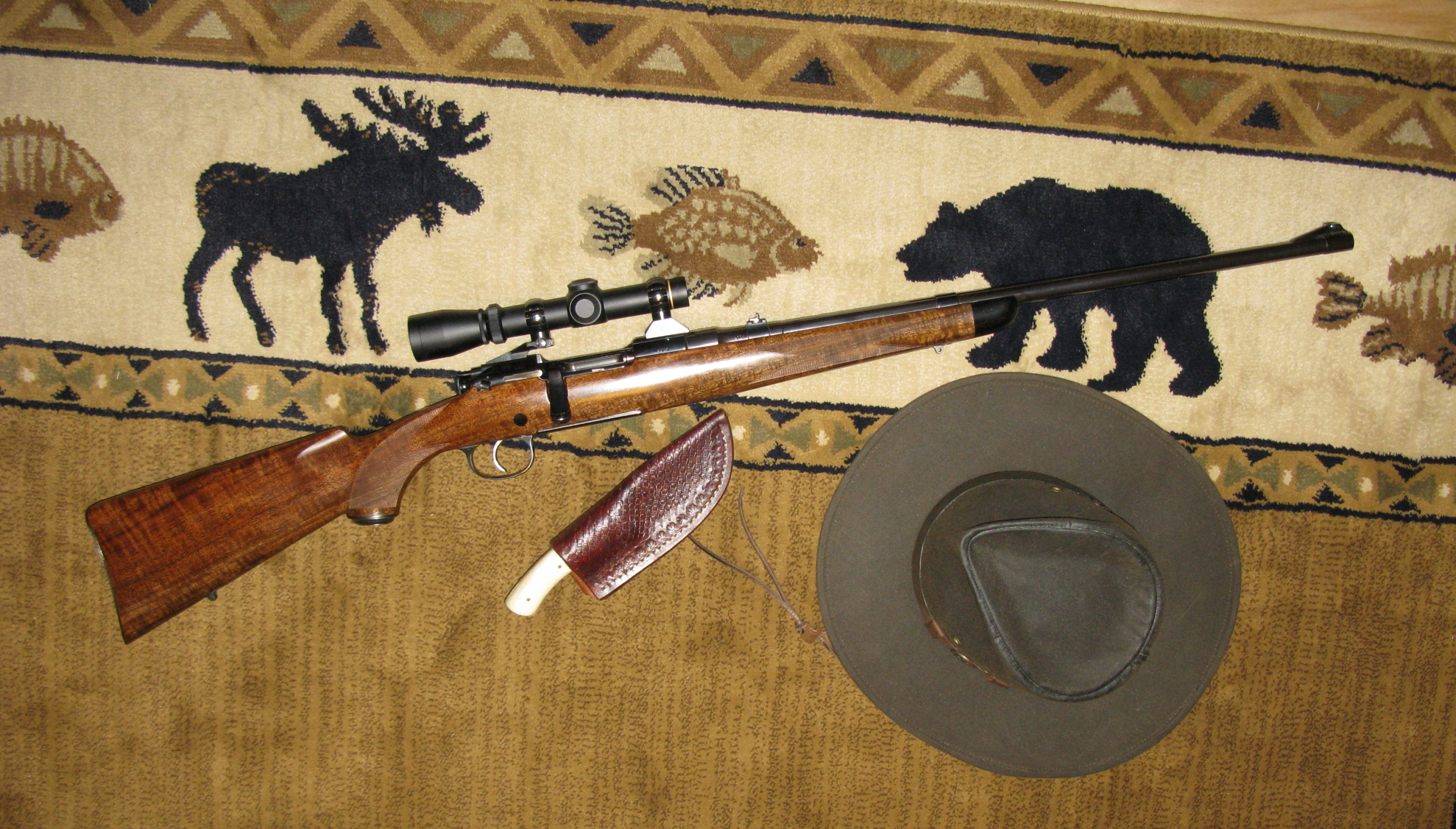
My 1950 Model Mannlicher Schoenauer Rifle in .30`06 Springfield
(Restocked by my Brother in Bastogne Walnut)
Fate took another course. Some time prior to this I had commissioned Fred Zeglin to build me a custom Model 1895 Browning to be the perfect traditional medium bore rifle for hunting the north woods. I wanted a rifle with the power to quickly dispatch a moose or a bear and enough reach to easily make shots at 200 yards. While Fred had reworked my Remington Model 700 in .340 Weatherby for my 1999 Alaskan hunt, this rifle would be my first completely custom project. These things take time, but as it happened, the 1895 was completed as I was making preparations for my Alaskan hunt and immediately the choice of rifle changed for the last time. Seeing its beauty I had some misgivings at first, but this rifle was built to hunt and all real hunts are messy affairs. It might as well get baptized in Alaska as in Alabama.
The Custom Model 1895 Browning
What I wanted was a potent medium caliber traditional weapon for hunting big game like elk and moose or the larger African plains game, such as kudu and eland. Fred Zeglin was the natural choice to do the work, given my prior satisfaction with his rebarreling of my .340 Weatherby and his familiarity with the 1895. I thought about several calibers for this rifle: .338-`06, .35 Whelen, 9.3 x 62 mm, .375 Hawk and and .411 Hawk, but finally settled on the .375 Hawk / Scovill as the optimum combination of power and trajectory.
The .375 Hawk and .375 Scovill are practically identical, the former being a creation of Bob Fulton and the latter of Dave Scovill. Conceptually, it is a 9.3 x 62 mm necked up to .375 caliber; the neck and shoulder dimensions follow the 9.3 x 62 mm, however, the cartridge base matches the common .30-06 Springfield rather than the slightly larger European 9.3 x 62 mm base. Moving the shoulder forward, it betters the old and revered (though obscure) .375 Whelen and .375 Brown-Whelen.
Anyone familiar with the 9.3 x 62 mm knows that this is a real thumper; it is generally exempted from the minimum .375 caliber rule in most parts of Africa. The .375 Hawk / Scovill can push a 270 grain bullet at 2500+ fps, retaining about 1800 fps and almost 2000 ft-lbs of energy at 300 yards. When you consider that the modern bonded core bullet, such as the North Fork Technologies design, will shed less than 10% mass on impact, as compared to at least 30% in a good bullet of yesteryear, that puts the .375 Hawk on a par in real terms with the the classic early 20th century .375 Holland and Holland Magnum - no mean performance.
The rifle began life as a vintage Grade I Browning Model 1895, produced some time back in the late 1980s or early 90s. Originally produced as the Winchester Model 1895, this lever action is the penultimate lever gun design by America's greatest firearms visionary, John M. Browning. It features a single stack vertical magazine that permitted the use of pointed bullets and is strong enough to use modern loads (although most experts suggest slightly reduced pressures to be gentle to the action). Mine is a Japanese reproduction license-built by Miroku for Browning in the late 1980s or early 1990s. Miroku also produces the latest Winchesters and they are of excellent quality.
I bought it pristine, new in the box, and sent it straight off to Fred, a virgin unfired. A perfectly good .30`06 barrel and set of plain factory stocks went in the scrap pile, but such are the sacrifices of custom work. The older Browning was preferred, despite supposed collector value, because it had no tang safety like on the newer Winchesters.
I asked for a heavy number 5 sporter contour Douglas XX premium chrome-molybdenum alloy barrel, 25 inches in length. In retrospect, I ought to have specified a number 4 contour because it is rather heavy and the recoil is milder than it has to be.
Since the Model 1895 permits use of pointed or semi-pointed bullets and when chambered in .375 Hawk / Scovill is capable of flat shooting and still quite effective at more than 200 yards, I thought that a forward mounted, low-powered telescopic sight would give it the full benefit of its ammunition without spoiling the classic styling. Having quick detachable mounts would still permit the rifle to be used with plain sights in the most traditional manner. I requested a quarter rib that would mount a low powered scope over the barrel in the "scout scope" style. Leupold makes a fine 2X scope precisely for this purpose and it works perfectly here. My only complaint is that it is not adjustable for focus and my astigmatism gives me trouble seeing the crosshairs unless I wear glasses; I don't have that problem with a scope mounted in the conventional location. The scope is secured with Talley TNT quick detachable mounts. The rifle also has a fixed standing rear sight and barrel banded front sight.
The rifle, shown below, is a pure pleasure to shoot. The following photos provide a closer look at the custom work performed on my Browning 1895.
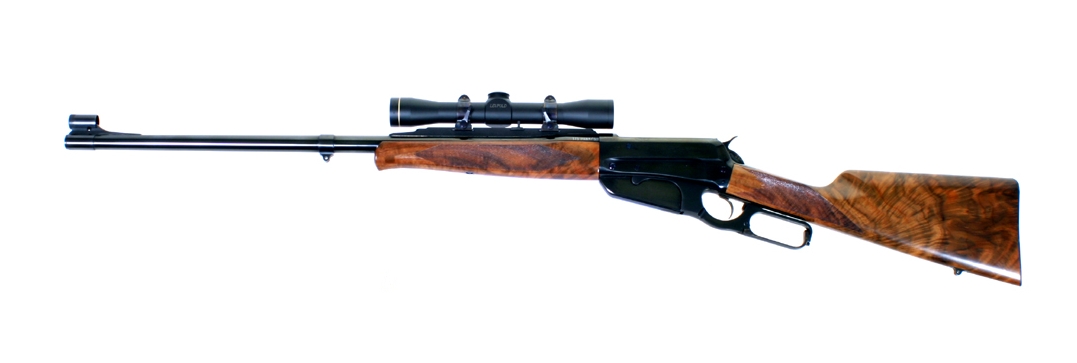
My Custom Browning Model 1895 in .375 Hawk/Scovill

Custom Browning Model 1895 with Scope Detached
The photos below shows the quarter rib with and without the Leupold 2X Scout Scope in place. It is secured by Talley TNT quick detachable rings that were color case hardened and with nitre blued screws, the metal finish work being done by Doug Turnbull. The quarter rib was custom fitted to the barrel specifically for this scope and the dovetails for the Talley bases cut by hand. A fixed standing blade was filed for my preferred load prior to final blueing.
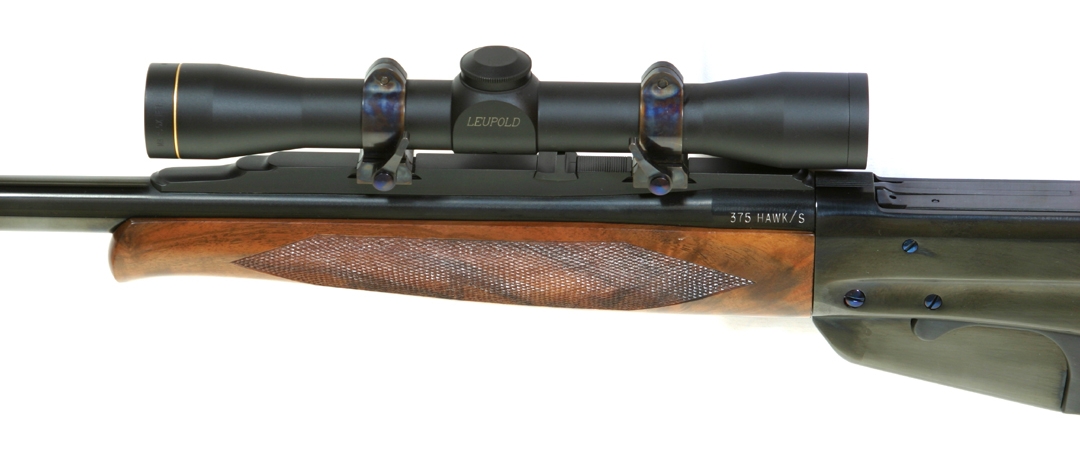
Quarter Rib with Leupold 2X Scout Scope
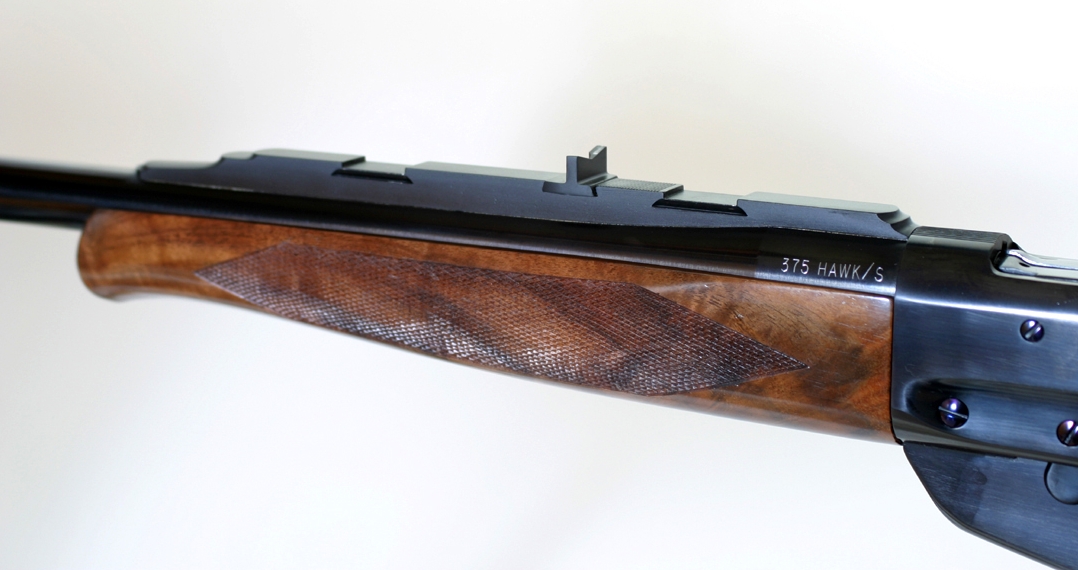
Quarter Rib Showing Fixed Rear Sight and Dovetail Cuts
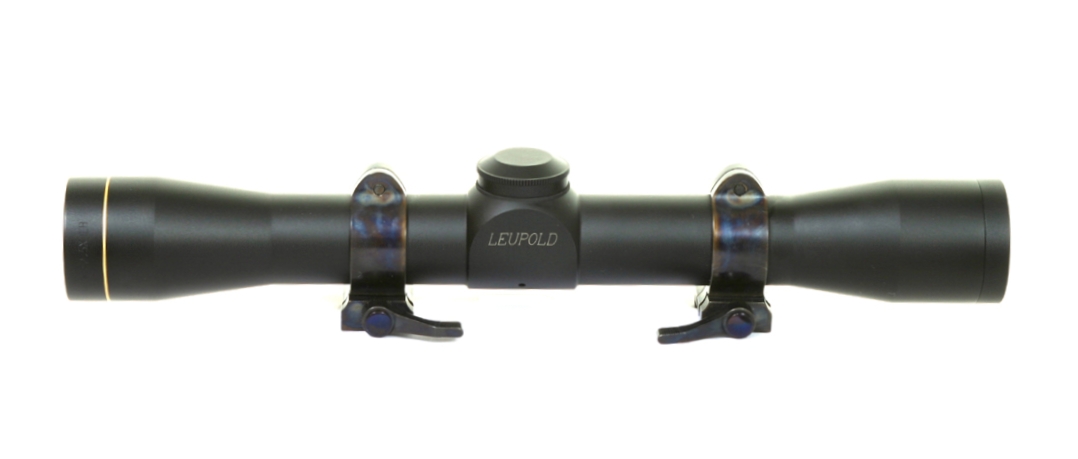
Close-Up of Scout Scope and Talley TNT Rings
I decided to replace the stock with a high grade Claro walnut that would increase the height of the comb for scope use without spoiling the classic lines of the original rifle. I selected my wood from a series of images of examples of blanks. You have to use some imagination when looking at blanks since the wood is unshaped and unpolished, but you can see the figure and judge how well it will work with the stock shape. I ended up choosing a medium priced piece (believe it or not) and proposed that the blank be inverted relative to the chalk line made by the wood shop in order to get more of the figure into the carved pattern and improve the flow. The stockmaker cut a nice point pattern checkering at 22 lpi that compliments the lines of the straight stock.
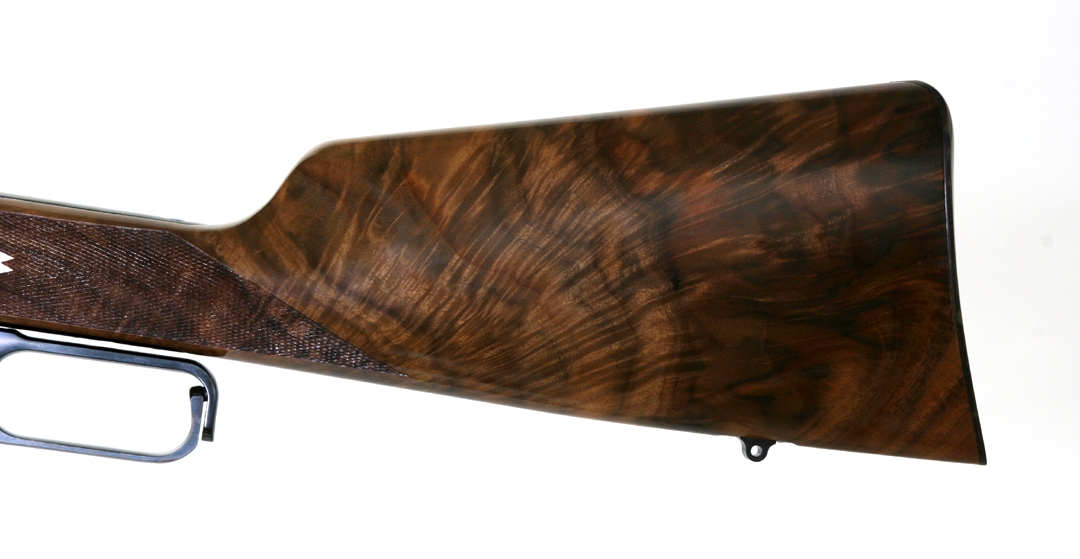
Close-Up of the High Grade Claro Walnut Stock
Despite this being a potent caliber, the buttstock was fitted for a gracefully contoured steel butt plate that was color case hardened. Recoil is not at all rough and it looks far better than with a rubber pad. Clocked screws are a nice touch.
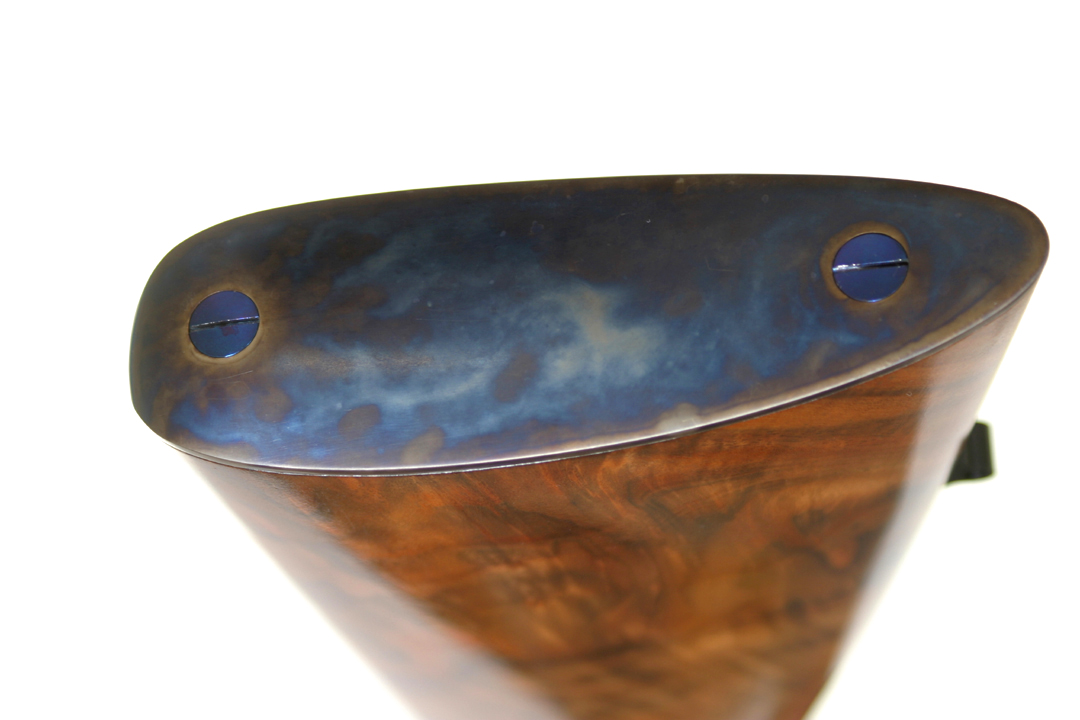
Color Case-Hardened Butt Plate
At my request, Fred sent off several of the small parts (hammer, trigger, lever, scope rings) to be color case hardened and the screws to be nitre blued by Doug Turnbull. I originally asked for the receiver to be color case hardened, but Turnbull would not do that work at that time owing to a concern about potential deformation. I have since seen examples of color case hardened 1895 receivers by Turnbull and that is something I may have done in future.

Close-Up of Receiver Showing Nitre-Blued Screws and Color Case-Hardened Hammer
Load Development and Range Work
There is some load data published on the .375 Hawk / Scovill, but little or none using the North Fork Technologies bullets that I intended to use. These bullets will typically achieve max loads with significantly less powder than conventional bullets, so its important to start low.
I preferred the 270 grain bullet because it provides the best balance of bullet weight (sectional density) and velocity. It is also the standard weight of the old classic .375 caliber British sporting cartridges, such as the .375 Nitro Express, Holland .400/.375 Belted Rimless Nitro Express and .375 Rimless Nitro Express (aka 9.5 x 56 mm Mannlicher-Schoenauer). The closest of the old nitro expresses was the .369 Purdey, a true .375 caliber cartridge with almost exactly the same ballistics as the .375 Hawk / Scovill. All that said, the tough contruction of the North Fork 250 grain bullet makes as good a choice for nearly any hunting situation. You can also drive a 300 grain bullet to about 2350 fps, but that is both more bullet than is needed and not nearly as flat shooting.
I first tried the Winchester ball propellant W-748, but observed evidence of high pressure when tested in warm weather. This is a notorious problem with all ball propellants and that I have observed with other loads. I have now destroyed all my ball powder and won't use any such propellant ever again. Its not worth the risk to me. Hodgdon H-414 did not exhibit any unexpected pressure signs, but it also failed to deliver respectable velocities. It was H-414 that gave a 300 fps jump in velocity in my 7mm-08 on a hot day, so here again I just won't use any ball propellant.
Casting about for something better, I decided to try the 270 grain North Fork bullets with IMR-4320 and found a load that clocks around 2525 fps with no excessive pressure indicators in warm weather and provides fine accuracy. Other powders worth trying are Hodgdon H-4895 and Alliant Reloder-15.
The table below describes the load development that I undertook. All loads used brass by Quality Cartridge and CCI-200 large rifle primers. I used the case head measurement method to estimate the pressure, however the chamber on this rifle is cut such that case head expansion is significant relative to an unfired case and so this did not turn out to be a very useful guage. The max loads shown below are those that give muzzle velocities near the expected maximum with no sign of high pressure (other than the previous comment about W-748).
Warning: Use this load data at your own risk. No liability is assumed for the use of this data in any other firearm. It appeared to be safe in the test rifle, but was not subjected to pressure testing. Exercise safe reloading practices. Starting loads should always be reduced by 15% from the maximum load.
Table of Load Development Testing
| Bullet | Propellant | Muzzle Velocity | Notes |
| .375-250 gr North Fork | Winchester W-748 | COL 3.210 in | |
| 57 gr | 2497 fps | ||
| 58 gr | 2580 fps | ||
| 59 gr | 2603 fps | Accurate | |
| .375-270 gr North Fork | Winchester W-748 | COL 3.210 in | |
| 56 gr | 2459 fps | Pressure signs in warm weather | |
| 57 gr | 2493 fps | Pressure signs in warm weather | |
| Hodgdon H-414 | COL 3.210 in | ||
| 56 gr | 2250 fps | ||
| 57 gr | 2277 fps | ||
| 59 gr | 2347 fps | Accurate | |
| 60 gr | 2348 fps | Accurate | |
| IMR-4320 | COL 3.210 in | ||
| 54 gr | 2347 fps | ||
| 55 gr | 2389 fps | ||
| 56 gr | 2426 fps | ||
| 57 gr | 2464 fps | ||
| 58 gr | 2525 fps | Accurate; Maximum |
My best grouping so far has been 1.5 inches at 200 yards with two bullet holes touching on the centerline of the sighting target; typically I get 3 inch groups at that range, which is not bad at all. The 200 yard shooting was important because the bullets did not group quite where I predicted they would based on the 100 yard group. Word to the wise: if you haven't shot a target at long range, you don't know where the bullet is going. It turns out that (probably due to the forward mounting) the adjustments were not what you would normally expect.
The Hunt
We arrived in Anchorage on 10 September 2004. Next morning we went to the Lake Clark Air hangar at Merrill Field where our bush pilot Willie from five years before remembered us and my brother's handmade oak pack frame. Willie flew us in the Navajo Chieftain to Port Alsworth on Lake Clark. We noticed that the glaciers had shrunk almost to nothingness in the intervening five years. Believe what you will about global warming, but our climate is changing dramatically.
Mark Lang also remembered us and flew us into camp in his Blackhawk (a bush plane, not the MH-60). It was very windy most of the time, which was a blessing in disguise because this was early September and the bugs were still about. It was also the driest anyone could remember; the tundra was bone dry and it had not rained in weeks. That made movement a pleasant experience, notably in contrast to our previous hunt, but it also apparently affected the migratory behavior of the caribou and (I believe) the antler growth.
We were in an ideal location from the standpoint of surveying the surrounding terrain for miles in most directions. Lang had actually landed the Blackhawk on a promontory and we pitched out camp in the lee of that hillock. Hiking to the broad flat top of this structure we glassed all about before setting out on our stalks. I averaged about nine miles a day in wide looping stalks, out and back.
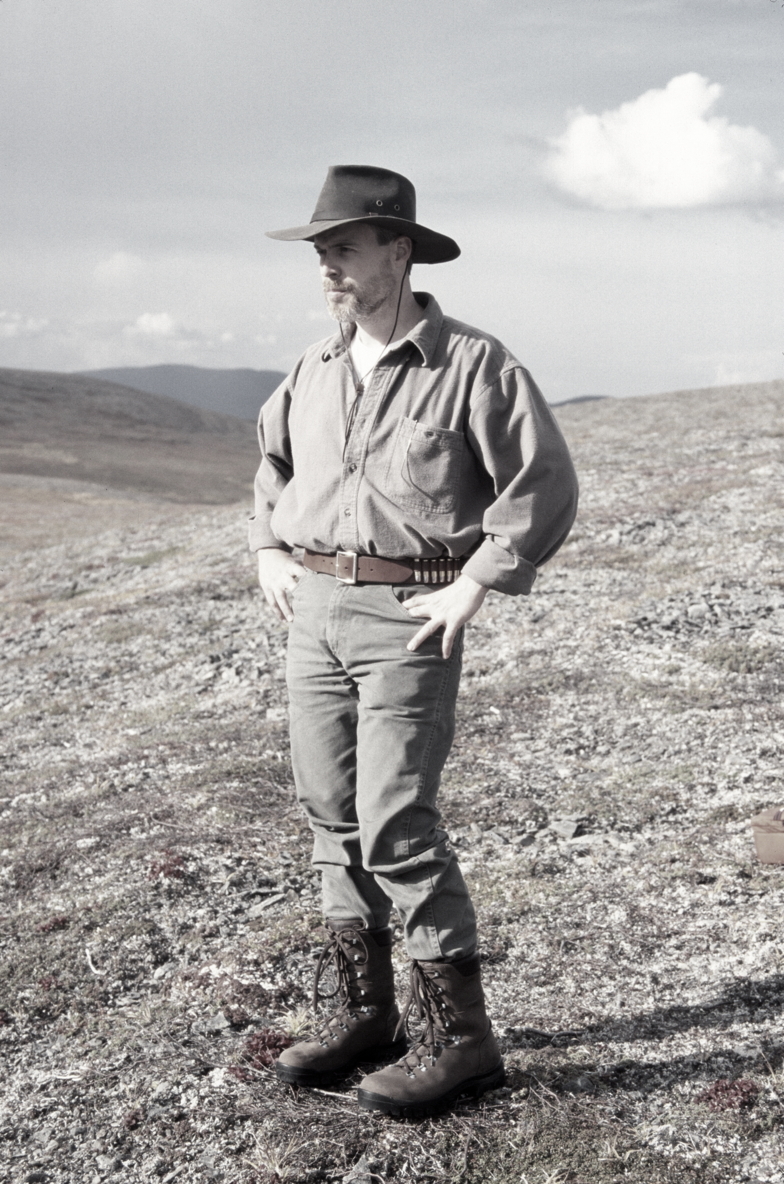
Standing on the High Hill above Our Camp
However, although we saw quite a number of caribou we were not seeing mature bulls. After three days we took the radical step of requesting a relocation. This is a risky decision because the move takes time and you cannot hunt on any day that you have flown in Alaska.
I won't belabor the details, but the short version of the story is that neither of us took a caribou that week. I never saw an animal that was as good as the ones we collected five years before and, partly owing to my eternal optimism and the fact that I had only one tag, I passed up the opportunity to shoot a lesser animal simply to get something. Honestly, though, I never passed up a bull that was mature. I am not that finicky and have taken my trophy on the first day of a hunt in several instances.
I did manage several protracted stalks on promising herds, eventually closing to within 75 to 150 yards of several hundred caribou over the course of the week, but always the great trophy that I sought was simply not among them. The antlers were either of adolescents or possibly stunted by the dry weather. I leave that to a wildlife biologist to conclude. I also think that the Mulchatna herd may be overhunted. I worried about that five years ago and this time it really makes me wonder. Some folks contended that the main body of the herd was still many miles to the south, but I was surprised that we saw no mature bulls in so many animals over a number of days. We never saw any impressive racks taken by other hunters either, though I did see one that was nice and not too small. (Update: In 2007 the Alaska Department of Fish & Game banned the hunting of caribou in the Alaskan Peninsula area of the state due to sudden steep declines in the caribou population.)
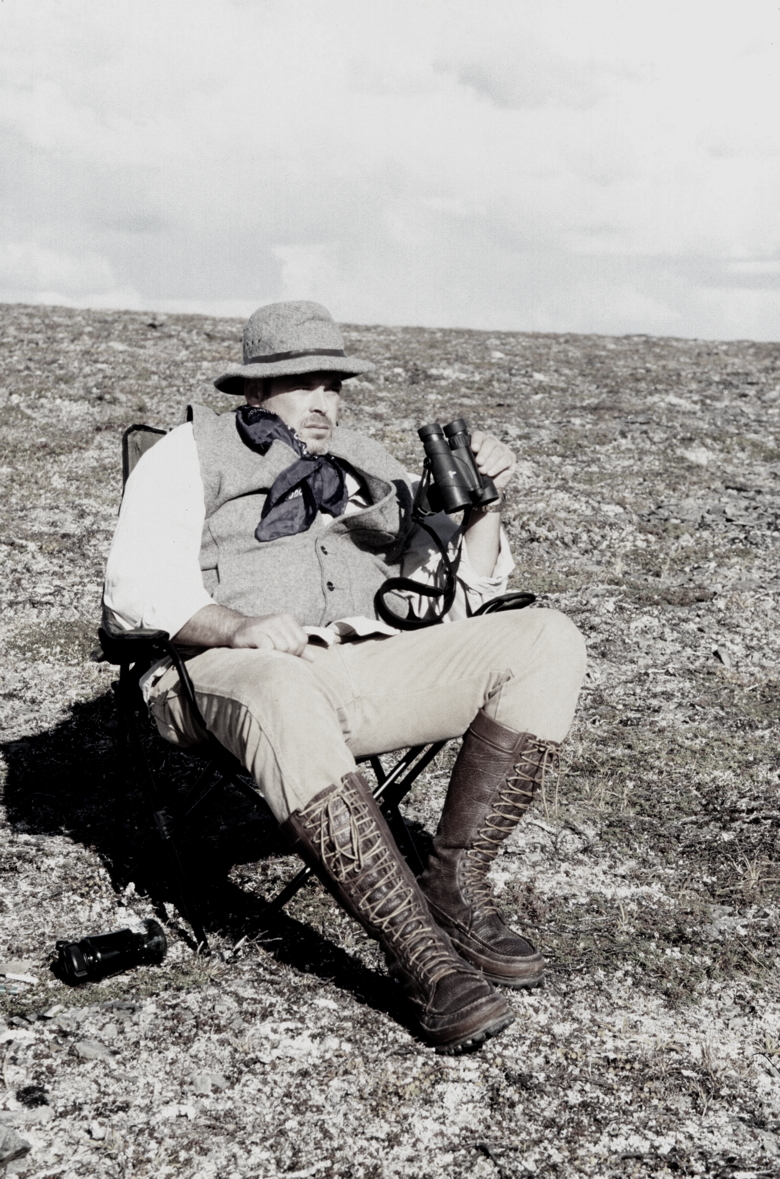
My Brother Glassing for Barren Ground Caribou of the Mulchatna Herd
On the last morning I could have walked a hundred yards and killed a cow for meat, but I decided that would be pointless. In my mind I had been successful as a hunter. I had spotted game, worked around to use the wind and terrain and approached to within easy killing range. I had done all the hunting - what I hadn't done was merely to pull the trigger. I enjoyed myself immensely, despite the disappointment of not collecting a trophy head.
The Hunt Redux
That said, the one thing that I had not done was to make a kill with the new rifle, so on my return I set about rectifying that shortfall. I hunt in the Bankhead National Forest, about an hour's drive from my home, where the state also manages the Black Warrior Wildlife Management Area (WMA). It has relatively few deer, but an unusually high proportion of big bodied deer, by Southern standards. I tallied the statistics collected by the rangers a few years back and the average live weight of bucks with eight points or more was 180 pounds. That is much larger than the typical mature buck elsewhere in this region and routinely this WMA produces bucks that weigh 200 to 240 pounds, which is downright shocking. [Since that time the WMA has attracted more popular attention and the average body weight has gone down precipitously] Most hunters wildly overestimate the weight of deer, just as they underestimate the weight of their rifles. Hunting in the WMA is very restricted, but its good country and I enjoy it. There are miles of undisturbed forest where no one ever penetrates because of the difficult terrain and the fact that most hunters want to hunt over a grassy opening by sitting in a stand. I hate that kind of hunting. I want to move through the woods and find my deer. If you kill a deer here you are either very lucky or you have earned it by hard work (or a bit of both).
Just before Christmas I killed a small buck (around 135 to 145 lbs) right at dusk. I nearly passed, but the freezer was bare and he kept walking right toward me, so I finally shot him at about twenty yards in the lower thorax, across the heart. In typical response, he took off in a crunched run, but that 1895 lever rifle with the low power scope was reloaded and came back on line faster than any rifle I have ever handled and I got another shot at about 125 yards that went through the boiler room from the opposite side as the first shot and ended the game. Either wound would have been sufficient, but I always take finishing shots at wounded game. I was as pleased with that young deer as with any other I have taken for the alacrity of its dispatch and the sense of pride I developed in dragging the carcass 1.5+ miles back to the road. A little luck and a lot of hard work.
Someday I will return to the north country with this rifle and hopefully encounter a fine caribou or perhaps a moose...
Wound Ballistics Contents
Copyright 2004 - 2013 -- All Rights Reserved